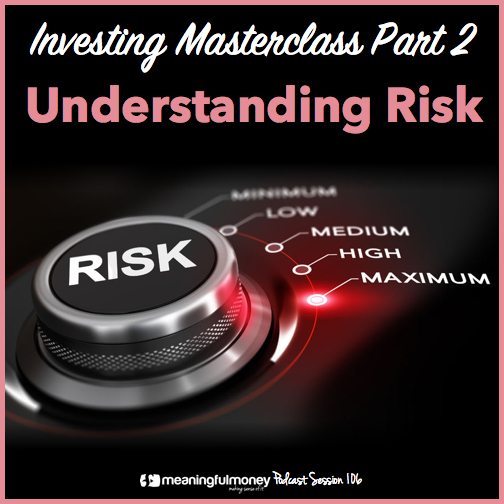
We continue our investment masterclass and this week we’ll be looking at risk and return. We covered this last way back in session 16 but I think it needs to be revisited in the particular context of risk when investing. So stay tuned, because your investing education continues shortly…
Podcast: Subscribe in iTunes | Play in new window | Download
If this show is of any use to you, it would help me massively if you would take the time to leave me a review on iTunes. This has a huge impact on keeping me near the top of the rankings, which in turns helps more people to find the show and to subscribe. I’ll remind you again at the end of the show, but if you want to do it right now, just click the button below:
Sponsor Message
 This podcast is brought to you with the help of Seven Investment Management, a firm of investment managers based in London. They specialise in multi-asset investing, bringing institutional investing techniques to ordinary people like you and me. 7IM put their name to my show and to my site because they believe in what I’m doing, trying to get decent, easy-to-understand financial information out to the world. I’m very grateful to them for their support.
This podcast is brought to you with the help of Seven Investment Management, a firm of investment managers based in London. They specialise in multi-asset investing, bringing institutional investing techniques to ordinary people like you and me. 7IM put their name to my show and to my site because they believe in what I’m doing, trying to get decent, easy-to-understand financial information out to the world. I’m very grateful to them for their support.
You can see what they’re up to at 7im.co.uk
Introduction
Risk is an unavoidable part of investing. The two go together like, well, two things which are meant to go together. Like Andy Murray and Kim Sears, perhaps. It isn’t a very pleasant word though, RISK. It’s a horrible four letter word that most people would like to avoid if at all possible, but it isn’t possible, so you might as well learn to work with it.
And that’s the point. Risk is something to be harnessed. It is to be understood and then set free to do its thing, and in doing so your returns should be more predictable and rewarding. With risk comes reward, as sure as night follows day, if you get it right.
Everything you need to KNOW
Risk means many things
Listen back to Session 16, and you’ll pick up these four kinds of risk:
- Mortality/Morbidity Risk
- Inflation Risk
- Investment Risk
- Inertia Risk, or opportunity cost
Volatility
Standard Deviation is a statistical measurement which, when applied to an investment fund, expresses its volatility, or risk. It shows how widely a range of returns varied from the fund's average return over a particular period. Low volatility reduces the risk of buying into an investment in the upper range of its deviation cycle, then seeing its value head towards the lower extreme.
For example, if a fund had an average return of 5%, and its volatility was 15%, this would mean that the range of its returns over the period had swung between +20% and -10%. Another fund with the same average return and 5% volatility would return between 10% and nothing, but there would at least be no loss.
Correlation
Correlation is about similarity (or not) of the behavior of two or more different things.
Correlation between two asset classes is measured in percent. If there is a 50% correlation between two asset classes, then when one asset was going up, then half the time, the other was going up too. A correlation figure of -70% would mean that historically, 70% of the time the two asset classes were moving in opposite directions.
Two assets which perfectly negatively correlate will stand still. If one goes up the other goes down by the same amount. This doesn’t happen in real life…
Likewise you don’t want two assets which closely correlate because you might as well hold just one.
Attitude to risk
It is really important to understand your attitude to investment risk, but it is a difficult thing to pin down. It’s very subjective and arguably it is one of a professional adviser’s core skills, to be able to pick up the subtle verbal and non-verbal cues from a client when discussing this topic.
If you want to measure your own risk profile, the best place to do that is at MyRiskTolerance.com. It will cost you £30 to do this, and that’s per person, but if you want anything done right it is worth paying for. The Finametrica system above is the market leader internationally, and is a very scientific process.
It’s really important not to try and second guess the system. Answer the questions truthfully. Usually go with your first instinctive answer, but don’t rush it.
Capacity for loss
A key question is whether or not you can AFFORD to lose some or all of your investment. One way of answering this question is to determine how much your investment is worth as a percentage of your total liquid wealth.
e.g., investment is £10,000; total liquid wealth £100,000. If you lose 50% of your investment, then you have lost just 5% of your total liquid wealth. You can probably afford to be adventurous with that money.
e.g.2 investment is £10,000; total liquid wealth £15,000. If you lose half your investment you have lost a third of your total liquid wealth. Ouch.
Everything you need to DO
1 – Identify your own attitude to risk and capacity for loss
Do the MyRiskTolerance.com profiler. If you’re in a couple, do it separately without conferring, and then compare the output. If they are wildly different figure out how you’re going to compromise.
Establish your affordability quotient. What percentage of your liquid wealth is the proposed investment going to be?
2 – Establish Timescale
The nearer you are to a fixed point in time, the less risk you should take. Established wisdom says that if you are within 5 years of your target date, then you should be taking little to no risk and keep the money in cash instead (not actual cash, but 100% safe bank deposits).
Realistically you will probably phase into cash over the five years, as that’s a long time to lose out on the potential growth of the market. So you might shift 20% of your investment into cash with five years to go, another 20% with four years to go etc. But this is only the case when heading towards a cliff-edge moment when you need the cash for use on some purchase.
This ‘lifestyling’ should be done intentionally as part of an annual review of your investments and targets and not abdicated to a lifestyling default as part of a pension or investment product.
3 – Set Targets
More on this in two weeks’ time. (Taking a week’s break from the investing masterclass to talk about budgeting next week.) Remember you should be investing for a purpose. Try to put a number on what you’re trying to achieve.
You’ll need to bear inflation into account. This makes planning more than a few years out difficult, but I’ll try to help with that in a couple of weeks’ time
4 – Allocate accordingly
Talked about Asset Allocation last week, its importance and the difference between strategic and tactical allocation
Once you have established your attitude to risk, determined your timescale and set a realistic target, you’re going to want to build a portfolio that aims to satisfy those three criteria.
This involves blending assets with different risk profiles (volatility) and behaviours (correlation) to achieve your goals. And that my friends, is where the science is!
Summary
OK, we’re building things up slowly here. We’ve covered asset allocation and today we’ve looked long and hard at risk and its effect on your portfolio, and on you as an investor.
As I said, we’re taking a short break next week to look briefly at budgeting – a really, REALLY important subject without which you’ll never get anywhere.
Then in two weeks’ time we look at setting realistic targets, taking account of inflation and all that jazz.
Don’t forget, a full transcript is available if you hit the button below:
Resources
Session 16 on Risk – Listen here
MyRiskTolerance from Finametica – Do your own risk profile
Reviews
Big thanks to IanB in the UK, for his reviews this week – much appreciated!
Don’t forget to go to meaningfulmoney.tv/iTunes or hit the big red button below to leave a review – it really helps!
Next Session Announcement
Next time we'll be talking about Budgeting. Such an important subject which I covered right back at the start in Session 3 but which I want to revisit in light of the launch of MeaningfulUniversity.com in a couple of weeks time, and even more so because I had a great email from a listener called Martin sharing his success…
If you have a question on this subject, or any other financial query that you want answering here on the show, then the best way to do that is to leave me a voicemail at meaningfulmoney.tv/askpete





Leave a Reply